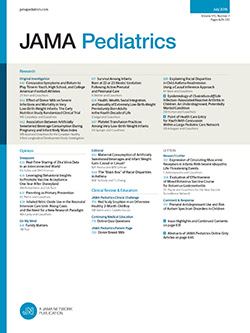Trends in Maternal, Fetal, and Infant Mortality in the US, 2000-2023
IF 24.7
1区 医学
Q1 PEDIATRICS
引用次数: 0
Abstract
ImportanceAccurately measuring maternal mortality trends has been challenging due to changes in data collection. This work disambiguates trends from the effects of introducing the pregnancy checkbox on death certificates and also analyzes closely related fetal and infant mortality.ObjectiveTo describe trends in maternal, fetal, and infant deaths since 2000, including the impact of the COVID-19 pandemic.Design, Setting, and ParticipantsA national, population-level, epidemiological, cross-sectional analysis during 2000 to 2023 was conducted as well as a staggered difference-in-differences analysis on the pregnancy checkbox, using the US Centers for Disease Control and Prevention Wide-Ranging Online Data for Epidemiologic Research (WONDER) database on underlying causes of death in the US to identify maternal, infant, and fetal deaths. Study population was restricted to mothers aged 15 to 44 years for all definitions of maternal mortality.ExposuresStaggered introduction of the pregnancy checkbox on death certificates across different states.Main Outcomes and MeasuresLongitudinal study (2000-2023) reporting crude rates per 100 000 population for adjusted maternal mortality and per 1000 population for fetal and infant mortality at the national level and by US Census Bureau–designated main census regions, age groups, and race and ethnicity. Staggered difference-in-differences counterfactuals (1999-2023) on impact of pregnancy checkbox.ResultsThe introduction of the pregnancy checkbox was associated with 6.78 (95% CI, 1.47-12.09) deaths per 100 000 live births increase in reported maternal mortality, 66% (95% CI, 14%-117%) of the total increase from 2000 to 2019, with a smaller impact on maternal mortality excluding cause unspecified (adjusted maternal death rates). Adjusted maternal death rates remained consistently between 6.75 (95% CI, 5.97-7.61) to 10.24 (95% CI, 9.22-11.34) per 100 000 live births from 2000 until 2021, when it peaked at 18.86 (95% CI, 17.48-20.32); the rate dropped to 10.23 (95% CI, 9.22-11.32) in 2022. The death rates of Native American or Alaska Native women increased the most during the COVID-19 period, almost tripling from 2011 to 2019 (10.70 per 100 000 live births; 95% CI, 7.64-14.57) to the 2020 to 2022 period (27.47 per 100 000 live births; 95% CI, 18.39-39.45). The death rates of non-Hispanic Black women were highest across time—approximately triple the rate of non-Hispanic White women in each time period. Infant death rates per 1000 live births dropped from 6.93 (95% CI, 6.85-7.01) in 2000 to 5.44 (95% CI, 5.36-5.51) in 2020, increasing slightly to 2018 levels in 2021 to 2023. Fetal death rates per 1000 live births decreased from 6.28 (95% CI, 6.16-6.31) in 2005 to 5.53 (95% CI, 5.45-5.60) in 2022.Conclusion and RelevanceUsing difference-in-differences analyses, results of this study reveal that the pregnancy checkbox explained much of the observed increase in maternal mortality before the COVID-19 pandemic. Nevertheless, results of this cross-sectional study suggest that, even adjusting for pregnancy checkbox effects, most groups saw increases from 2011 to 2019 to the 2020 to 2022 period, indicating that the COVID-19 pandemic led to worse outcomes. The findings demonstrate the relevance of public health emergencies to maternal health outcomes.2000-2023年美国孕产妇、胎儿和婴儿死亡率趋势
由于数据收集的变化,准确测量孕产妇死亡率趋势一直具有挑战性。这项工作消除了在死亡证明上引入怀孕复选框的影响的趋势,并分析了密切相关的胎儿和婴儿死亡率。目的描述自2000年以来孕产妇、胎儿和婴儿死亡的趋势,包括COVID-19大流行的影响。设计、环境和参与者:使用美国疾病控制和预防中心广泛的流行病学研究在线数据(WONDER)数据库,对美国潜在的死亡原因进行了2000年至2023年的全国、人口水平、流行病学、横断面分析,并对怀孕复选框进行了交错差异分析,以确定孕产妇、婴儿和胎儿的死亡。研究人群仅限于年龄在15至44岁之间的母亲,以确定产妇死亡率的所有定义。不同州在死亡证明上错开了怀孕复选框。主要结果和措施纵向研究(2000-2023年),报告国家一级和美国人口普查局指定的主要人口普查地区、年龄组、种族和民族的每10万人口调整后孕产妇死亡率和每1000人口调整后胎儿和婴儿死亡率的粗比率。对怀孕影响的交错差异反事实(1999-2023)复选框。结果妊娠复选框的引入与报告的孕产妇死亡率每10万例活产死亡增加6.78例(95% CI, 1.47-12.09)相关,占2000年至2019年总增加的66% (95% CI, 14%-117%),对排除未明确原因的孕产妇死亡率(调整后的孕产妇死亡率)的影响较小。从2000年到2021年,调整后的孕产妇死亡率一直保持在每10万活产6.75 (95% CI, 5.97-7.61)至10.24 (95% CI, 9.22-11.34)之间,峰值为18.86 (95% CI, 17.48-20.32);到2022年,这一比例降至10.23 (95% CI, 9.22-11.32)。在2019冠状病毒病期间,美洲原住民或阿拉斯加原住民妇女的死亡率增幅最大,从2011年到2019年几乎增长了两倍(每10万活产10.70例;95% CI, 7.64-14.57)至2020年至2022年期间(每10万活产27.47例;95% ci, 18.39-39.45)。非西班牙裔黑人妇女的死亡率在各个时期都是最高的——大约是非西班牙裔白人妇女死亡率的三倍。每1000名活产婴儿死亡率从2000年的6.93(95%置信区间,6.85-7.01)降至2020年的5.44(95%置信区间,5.36-5.51),2021年至2023年略有上升至2018年的水平。胎儿死亡率从2005年的每1000例活产6.28例(95%置信区间,6.16-6.31)下降到2022年的5.53例(95%置信区间,5.45-5.60)。结论和相关性通过差异中差异分析,本研究的结果显示,怀孕复选框解释了COVID-19大流行之前观察到的孕产妇死亡率上升的大部分原因。然而,这项横断面研究的结果表明,即使调整了怀孕复选框效应,大多数群体在2011年至2019年至2020年至2022年期间的怀孕率都有所上升,这表明COVID-19大流行导致了更糟糕的结果。调查结果表明突发公共卫生事件与孕产妇健康结果的相关性。
本文章由计算机程序翻译,如有差异,请以英文原文为准。
求助全文
约1分钟内获得全文
求助全文
来源期刊

JAMA Pediatrics
PEDIATRICS-
CiteScore
31.60
自引率
1.90%
发文量
357
期刊介绍:
JAMA Pediatrics, the oldest continuously published pediatric journal in the US since 1911, is an international peer-reviewed publication and a part of the JAMA Network. Published weekly online and in 12 issues annually, it garners over 8.4 million article views and downloads yearly. All research articles become freely accessible online after 12 months without any author fees, and through the WHO's HINARI program, the online version is accessible to institutions in developing countries.
With a focus on advancing the health of infants, children, and adolescents, JAMA Pediatrics serves as a platform for discussing crucial issues and policies in child and adolescent health care. Leveraging the latest technology, it ensures timely access to information for its readers worldwide.
 求助内容:
求助内容: 应助结果提醒方式:
应助结果提醒方式:


